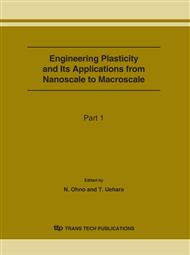p.483
p.489
p.495
p.501
p.507
p.513
p.519
p.525
p.531
Influence of Tensile Pre-Strain on the Torsional Fatigue Crack Behaviors of a Structural Steel
Abstract:
Structural steel is widely used in engineering even in nowadays and many new materials have been developed or are under developing. As one of the most common type, torsional fatigue properties are normally calculated from the rotating bending fatigue properties. In this study, the torsional fatigue properties of a structural carbon steel (S45C) with different tensile pre-strain ratio is investigated, especially on the effects of Mode II crack before it branches under different stress amplitudes. Based on the experimental results and microstructure observation, the main results obtained are: (1)Torsional fatigue strength is increased after tensile pre-strain deformation, and the fatigue limits increase with increasing of tensile pre-strain ratio, the highest improvement can be up to 125% of that of the plain specimen. (2) Torsioanl fatigue cracks initiate from the torsional slip lines in ferrite grains, and there is no obvious effect by the tensile pre-strain. With increasing of tensile pre-strain ratio, the fatigue crack initiation life ratio becomes later and the growth rate becomes faster. (3) The mode II crack length along the axial direction becomes longer with increasing of tensile pre-strain ratio, and the crack branch direction does not affected by the tensile pre-strain. Moreover, the length along axial direction is not affected by the stress amplitude change for specimens with the same tensile pre-strain ratio. (4) The length of non-propagating crack becomes shorter with increasing of tensile pre-strain ratio.
Info:
Periodical:
Pages:
507-512
Citation:
Online since:
June 2007
Authors:
Price:
Сopyright:
© 2007 Trans Tech Publications Ltd. All Rights Reserved
Share:
Citation:


